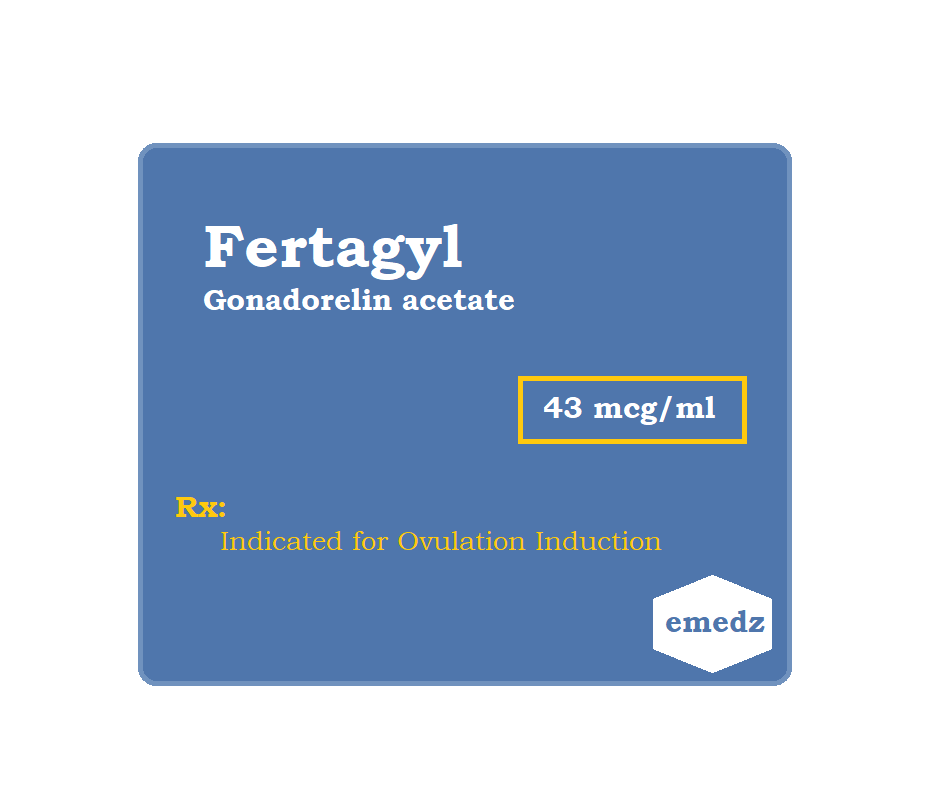Gonadorelin acetate (Fertagyl) is used for ovulation induction in female patients with amenorrhea and infertility caused by disorders of the hypothalamus and anterior pituitary gland.
Gonadorelin acetate Uses:
- It is indicated for ovulation induction in females with amenorrhea due to a hypothalamic cause.
Gonadorelin acetate dose in Adults
Gonadorelin acetate dose in the treatment of Primary hypothalamic amenorrhea:
-
Females:
- Initial dose: 5 mcg subcutaneously or intravenously every 90 minutes via a pulsatile pump.
- The dose may be adjusted every 21 days if required.
- If no response to treatment is observed after 3 treatment intervals, the dose may be increased (up to 20 mcg).
- To keep the corpus luteum healthy, the medication should be continued for two weeks after ovulation.
Note: Select the appropriate vials. A typical dose of 5 mcg is delivered with the use of a 0.8 mg vial.
Dose in Children:
Not indicated.
Pregnancy Risk Category: B
- Infants born to moms who had been exposed while pregnant were not reported to experience any negative side effects from the medication.
- It appears that there is very little risk to fetal harm. The risk of fetal abnormalities was not present when the drug was administered to mothers in the first trimester.
- To protect the corpus luteum, the medication should be continued for two weeks after ovulation.
- Once a pregnancy is confirmed, no further treatment is required.
Gonadorelin acetate use during breastfeeding:
- It has not been tested in lactating mothers. It is not recommended for use during breastfeeding.
Dose in Kidney disease:
Dosage adjustments have not been provided in the manufacturer's labelling. It has not been studied in patients with kidney disease.
Dose in Liver disease:
It has not been studied in patients with liver disease. Use it with caution.
Side effects of Gonadorelin acetate (Fertagyl):
-
Cardiovascular:
- Superficial thrombophlebitis
-
Local:
- Injection site irritation
Contraindications to Gonadorelin acetate:
- Allergy reactions to gonadorelin and any component of the formulation
- Pregnancy can exacerbate medical conditions such as pituitary probinoma.
- Patients suffering from ovarian cysts
- Reproductive hormones can worsen medical conditions like hormone-dependent tumors.
Warnings and precautions
-
Hypersensitivity and anaphylactic reactions
- Rarely have anaphylactic and allergic reactions been reported.
-
Ovarian cancer: [Canadian Boxed Warn]
- Although it is not possible to prove a causal link, some infertile women who received fertility drugs have been found to develop ovarian carcinoma.
- For patients who have used these drugs in the past, it is important to monitor for any unusual signs or symptoms.
-
Ovarian hyperstimulation Syndrome: [Canadian-Bound Warning]
- Ovarian hyperstimulation syndrome is a serious side effect of hormone stimulation. This is a heightened response to ovulation-induction therapy.
- This condition can develop within 24 hours of treatment but may worsen after seven to ten consecutive days.
- Mild to moderate OHSS symptoms include:
- Abdominal discomfort or distension
- diarrhea,
- Nausea and/or vomiting
- vomiting.
- Symptoms of severe OHSS could include:
- Extreme abdominal pain
- Anuria or Oliguria
- ascites,
- severe dyspnea,
- Hypotension, or
- Intractable vomiting and nausea
- Laboratory abnormalities in OHSS include:
- Reduce creatinine clearance,
- hemoconcentration,
- hypoproteinemia,
- Elevated liver enzymes
- electrolyte imbalances.
- Symptomatic treatment of OHSS should be discontinued.
- Stop taking gonadotropin medication.
- Symptomatic therapy is the treatment of pain and fluid abnormalities. It also prevents thromboembolic complications.
Monitoring parameters:
- Monitor LH, FSH, estradiol, progesterone in the mid-luteal phase, and body temperature.
- Perform a baseline ovarian ultrasound and then at weekly intervals until ovulation has been confirmed.
- Perform a pelvic check, and keep an eye out for any hypersensitive reactions at the injection site.
- At least two weeks after receiving HCG, patients should be checked for the clinical signs of ovarian hyperstimulation syndrome.
Monitoring parameters of OHSS that should be checked daily include:
- Daily monitoring:
- abdominal circumference,
- albumin,
- cardiorespiratory status,
- electrolytes,
- fluid balance,
- hematocrit,
- hemoglobin,
- serum creatinine,
- urine output,
- urine specific gravity,
- vital signs,
- weight
- Weekly monitoring:
- Liver enzymes should be checked weekly.
How to administer Gonadorelin acetate?
Lutrepulse vials for IV or SubQ use:
- The constituents of the medicine are first reconstituted and then administered as intravenous or a subcutaneous injection via a pulsatile pump.
- The infusion pump is set to deliver 25 or 50 mcL of the solution, depending on the required dose and the strength of the formulation used.
- When using the 0.8 mg vial, the pump can be set to deliver a dose of 2.5 mcg equivalent to 25 mcL per pulse or 5 mcg equivalent to 50 mcL per pulse.
- When using the 3.2 mg vial, the pump can be set to deliver a dose of 10 mcg equivalent to 25 mcL per pulse or 20 mcg equivalent to 50 mcL per pulse.
- The pump should deliver the dose over a pulse period of one minute and a pulse frequency of 90 minutes.
Mechanism of action of Gonadorelin acetate:
- It stimulates the anterior pituitary to release LH (luteinizinghormone), which results in induction of ovulation.
The onset of action:
- Treatment response is usually observed within 14 to 21 days.
Metabolism:
- It is metabolized primarily via the kidneys.
Half-life elimination:
- Terminal half-life elimination is about 10-40 minutes that is increased in patients with kidney disease.
Excretion:
- It is excreted in urine as inactive metabolites.
International Brand Names of Gonadorelin acetate:
- Lutrepulse
- Relisorm
- Cryptocur
- Gonavet
- HRF
- Kryptocur
- LH-RH Tanabe
- Luforan
- Lutamin
- Lutrelef
- Relefact
- Relefact LH-RH
- Relisorm L
- Wyeth-Ayerst HRF
- Zyklomat
Gonadorelin acetate Brand Names in Pakistan:
No Brands Available in Pakistan.







